Employee Management
You can add a new employee to your database using the Add New Employee operation.
For more information about adding a new employee, download the PDF document Adding a New Employee.
LTC clients usually compile spreadsheets manually and file direct care hours of agency or contract workers for PBJ purposes. The time and attendance software allows a generic placeholder employee to be created for last minute contracting of new agency workers to arrive onsite and punch at the clcck immediately.
You can add placeholder employees using the Add Employee operaton and adjust the sensitivity threshold to accept all fingers. Then you can modify properties of the placeholder employee with the information of the agency worked like first name, last name, workgropu assignement and more.
To add a placeholder employee for agency employees:
Click the Plus sign to expand Add Agency Staff menu group and select the Add Employee menu item.
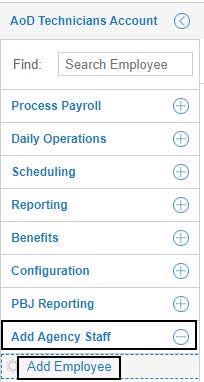
Specify the following properties when a placeholder employee is added.
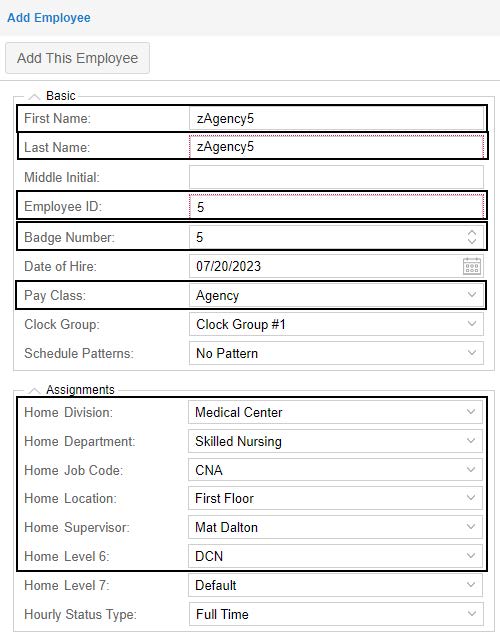
| Property | Descriptions |
|---|---|
| First Name | Enter zAgency1, zAgency2, zAgency3 etc. for placeholder purpose so that new agency workers can immediately punch upon arrival to the facility. |
| Last Name | Enter zAgency1, zAgency2, zAgency3 etc. for placeholder purpose so that new agency workers can immediately punch upon arrival to the facility. |
| Employee ID | Enter the employee id for the placeholder employee. |
| Badge Number | Enter the badge number for the placeholder employee. |
| Pay Class | Select Agency in the Pay Class drop-down list. |
| Assignments | Select a workgroup for each workgroup level. |
The employee is added with the detailed information displayed on the right side.
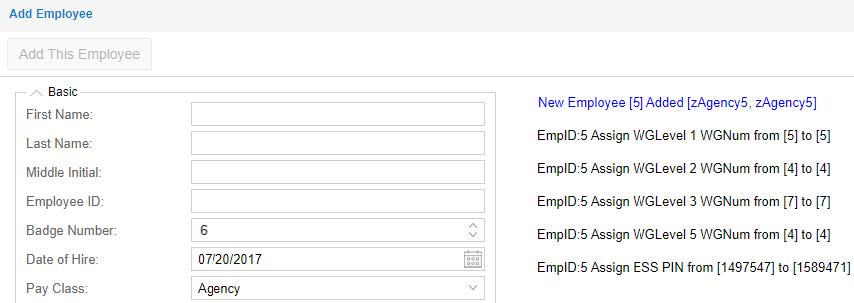
Repeat steps 1 to 3 to add more placeholder employees.
Enroll Your Finger Template for Placeholder Employees
Supervisor can temporarily enroll her/his finger template for all placeholder employees and adjust the sensitivity threshold for them with None, Accept Any Finger to accept any finger.
Enter agency in the Find field to locate all placeholder employees. Click an agency entry to drill down to this employee’s pages.

Select Personal Information in the first page drop-down list. Then select Templates in the second drop- down list. Click “Finger I/V Template”, the Biometric Template Properties dialog is displayed.
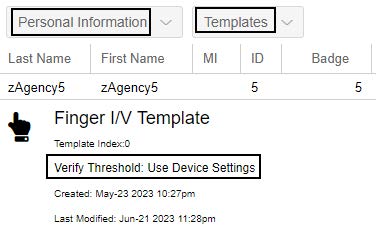
Select None, Accept Any Finger in the Verify Threshold drop-down list. Click Ok.
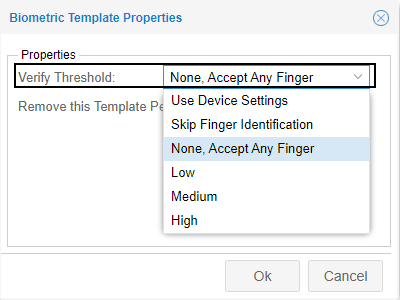
The Verify Threshold is updated with the selected None, Accept Any Finger.
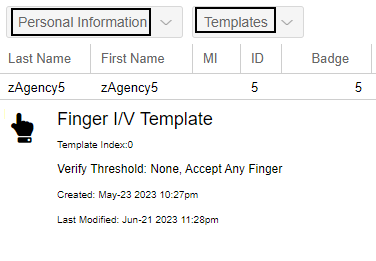
Repeat step 1 to 4 to adjust sensitivity threshold for all placeholder employees.
Replace Placeholder Employee Properties for Agency Workers
To replace placeholder employee properties by those of Agency workers:
Enter zagency in the Find field to locate all placeholder employees. Click an agency entry to drill down to this employee’s pages.

Select Personal Information in the first page drop-down list. Then select Basic in the second drop-down list. You can modify the Last Name and First Name fields with the real name of the agency worker.
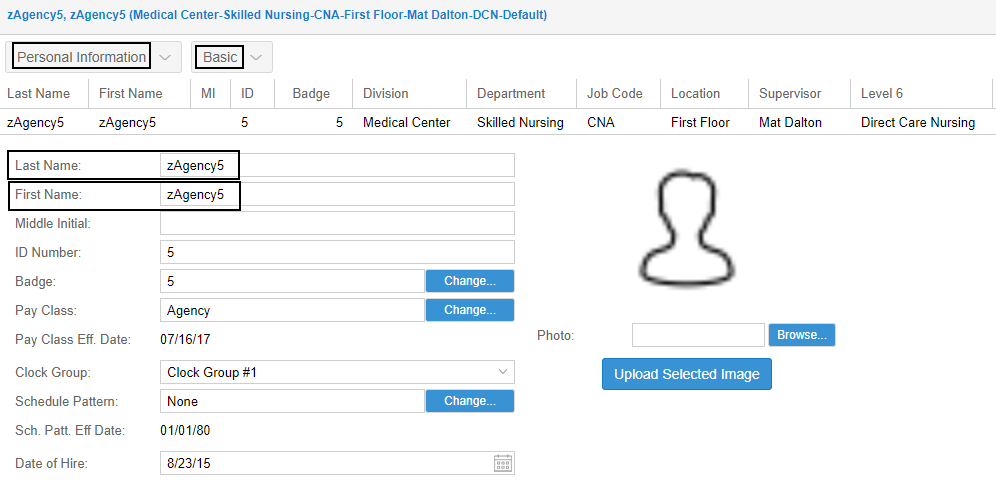
Select Workgroup in the second drop-down list. Then click the Pencil icon for the current workgroup assignment. The Adjust Current Home Workgroup Settings dialog is displayed.

Modify the workgroup for each workgroup level for this agency worker. Click Ok.
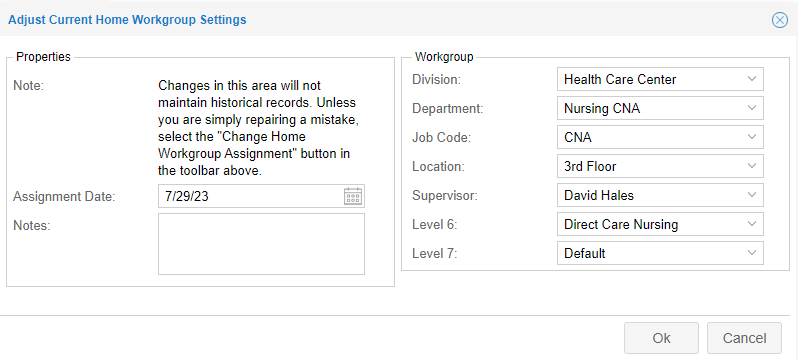
The current workgroup assignment is updated.

Repeat step 1 to 5 to replace placeholder employee properties with those of other agency workers.
For more information about adding a new employee, download the PDF document Adding Placeholder Employees for Agency Workers.
When an employee no longer works for a company, their employment is terminated. You must change their active status in their Active Status section of the Personal Information page by indicating the terminated condition and effective date. The terminated condition tracks why an employee is no longer employed, and can be used to determine whether a terminated employee is eligible to be rehired. Typical terminated status types are Disciplinary Action, On Leave, and Permanent.
You can terminate an employee in your system by following the steps below:
- Locate the employee record using the Find field. Type all or part of the employee’s name.
- Hit Enter on your keyboard.
- Click the employee’s name in the list of results returned by the employee search.
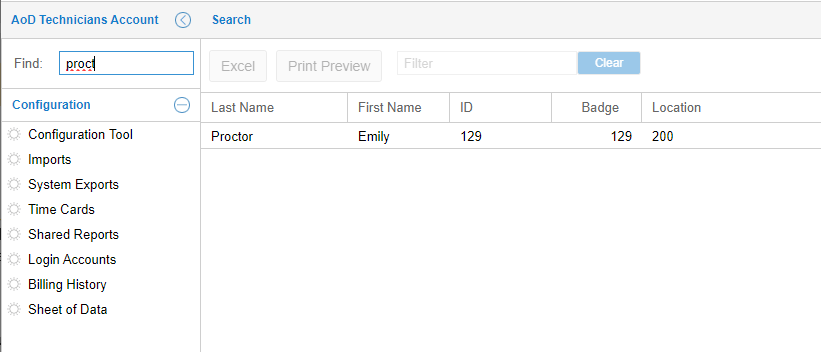
- In the employee’s time card, select Personal Information from the Time Card drop-down list.
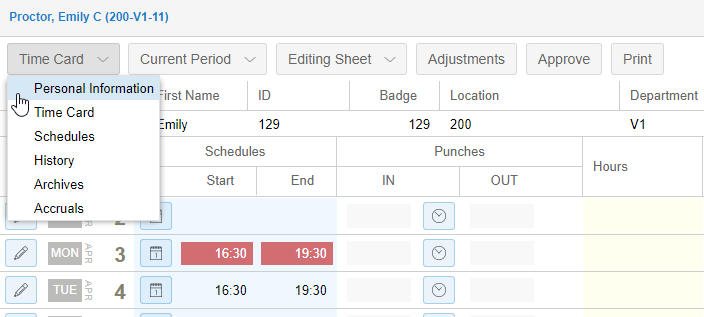
- Select Active Status from the Basic drop-down list.
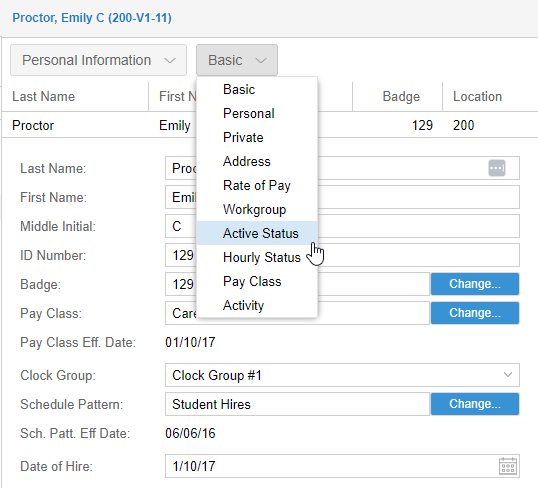
- Click the Change Active Status button in the Active Status page.
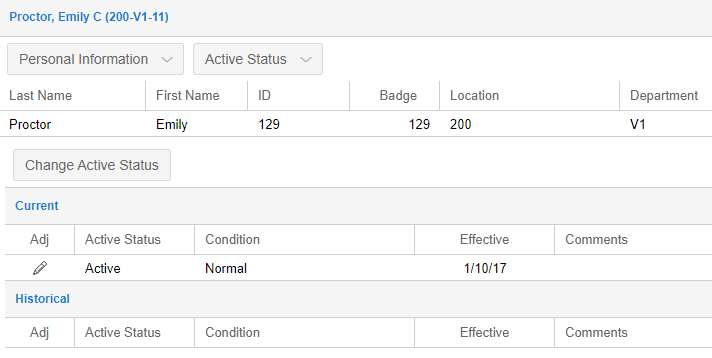
- Select Terminated in the Active Status drop-down list in the Assign New Active Status window.
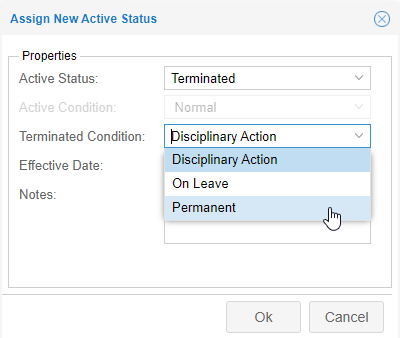
- Select Permanent in the Terminated Condition drop-down list.
- Select the effective date for termination in the Effective Date field.
- Add a note in the Notes field if needed. Click Ok.
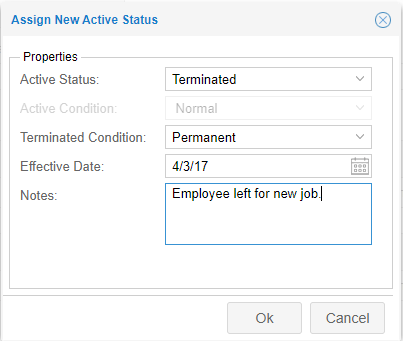
Note: An employee’s current status can be adjusted by clicking the pencil icon. This method is recommended only for repairing status settings, such as those that might occur during import, not for terminating an employee permanently. 
Only the Change Active Status button will preserve the employee’s historical records. 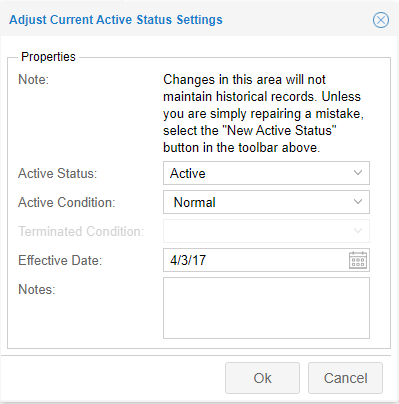
For more information about terminating an employee, download the PDF document Terminating an Employee Record.
A pay class, such as hourly, salary or contract, can be added or adjusted in an employee’s personal information in Manager Self Service (MSS). The pay class section of an employee’s personal information contains current and historical information about the pay classes that have been assigned to the employee’s record.
For more information about adjusting an employee’s pay class, download the PDF document Adjusting an Employee’s Pay Class.
Certifications can be added to an employee record in the employee’s personal information.
For more information about adding certifications to an employee record, download the PDF document Adding Certifications to an Employee Record.
The Availability page in Manager Self Service (MSS) helps you track time slots when employees are unable to work and when employees prefer to work. From a single day block of time scheduled down to 30-minute interval to blocks of time for the entire month, the features in the Availability page can be used to schedule and display employee availability. This feature is ideal for managers who need to track part time employees, such as students, or employees who do not receive paid time off.
To add availability preferences for an employee in MSS:
Open the employee’s Personal Information page.
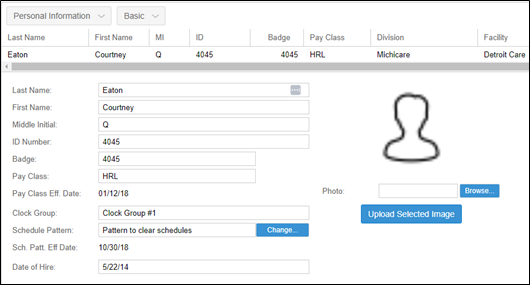
Select the Availability page from the Pages drop-down list.
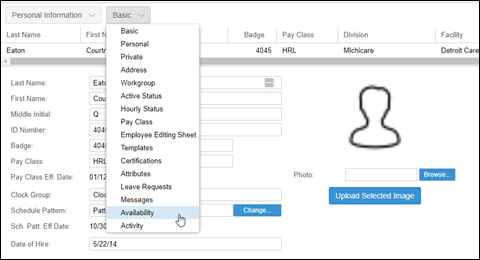
The Availability page displays a calendar view of the month selected in the drop-down list.
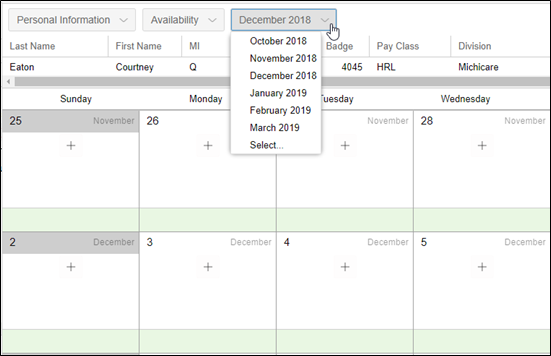
To add an availability preference for a single day, click the Plus icon + in the calendar date and select Set Temporary Availability.
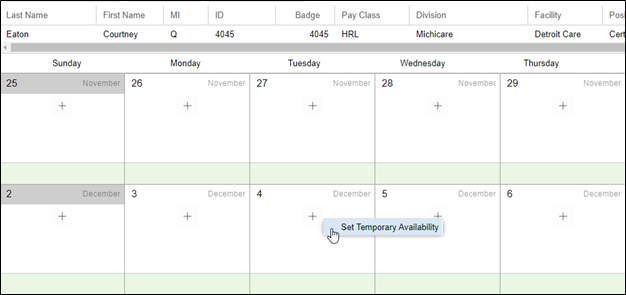
In the Register Availability window, select the indicator (unavailable or preferred) and the day for availability. If you want to set the availability for several days in a row, enable the Multiple Days in a Row check box and enter the date in the To field to indicate the number of days.
 | 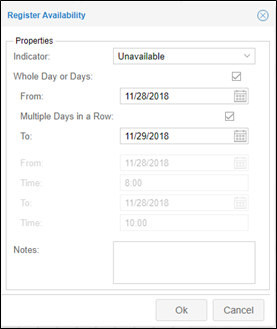 |
|---|
To schedule multiple availability preferences for the month, you can use the Availability Rotation feature, located in the panel below the Availability calendar. Click the arrow circle to expand the panel.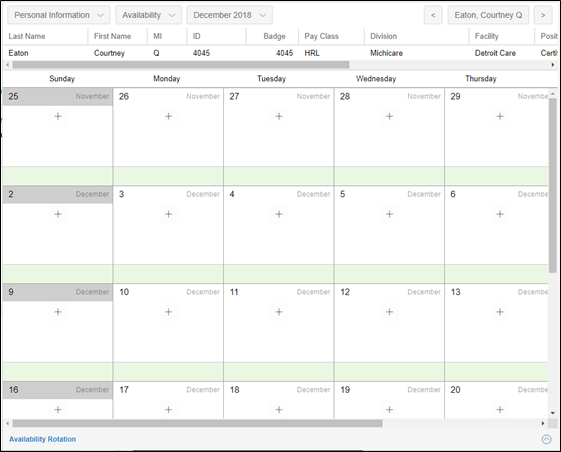
In the expanded Availability Rotation panel, click the Add New Rotation button.

In the Add New Availability Rotation window, select Every 7 Days for the duration.
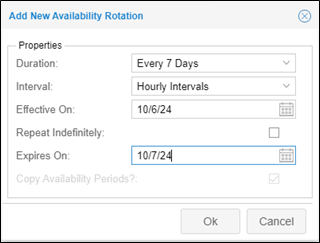
There are two settings in the Duration drop-down list: Every 7 Days and Every 14 Days. The option for Every 14 Days is not available at this time.
Select an interval for the availability rotation. There are there are two options:
• Hourly intervals
• Half-hour intervals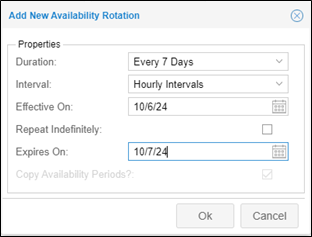
Select a date for when the availability will become active and when it will expire. Do not enable the Repeat Indefinitely check box.
Adding Availability Rules
In the Availability Rotation window, click the first cell next to the day of the week to enter availability details for that day. You can also enter details by clicking the Add New Work Preference Period button.
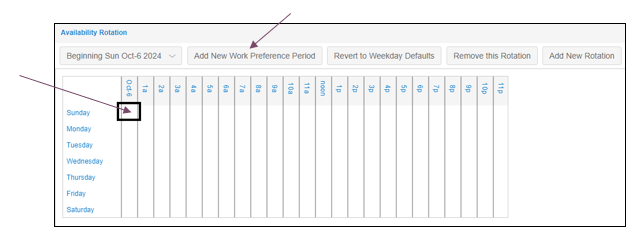
In the Add Availability Rule window, select the preference type (unavailable or preferred). Select the duration of the availability by enabling the Full Day check box or adding a time interval in the Start Time and End Time fields.
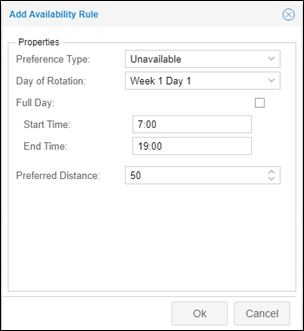
The availability rotation is effective immediately on the date you selected. Your chart will display the time interval for each rotation rule added: unavailable in red and preferred in blue.
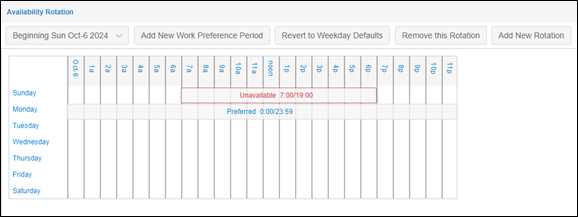
An availability rotation is also displayed in the employee’s Availability page calendar.
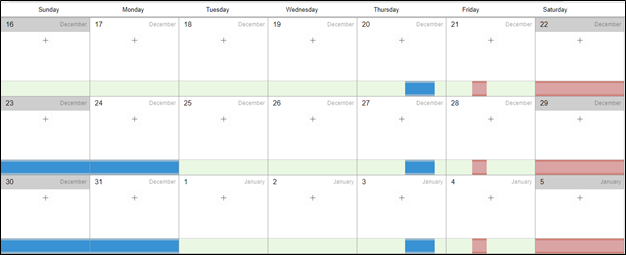
Multiple Rotations
You can add another rotation rule by clicking the Add New Rotation button.
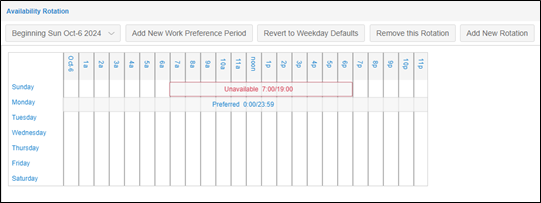
When adding the interval dates for the new rotation, be sure to avoid overlapping with your existing rotations.
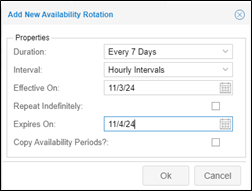
The Copy Availability Periods feature is not available at this time.
To change your rotation view when you have multiple rotations, click the beginning date button to select the rotation from the drop-down list.
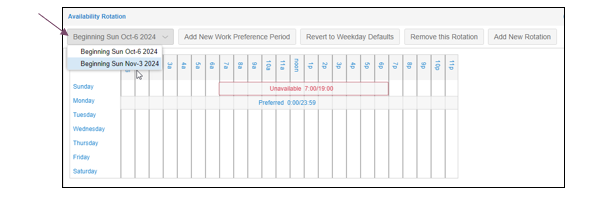
Adjusting or Removing a Rotation
To make a change to a rotation rule in your availability rotation, click in the area on either side of the rule bar text in the rotation chart.
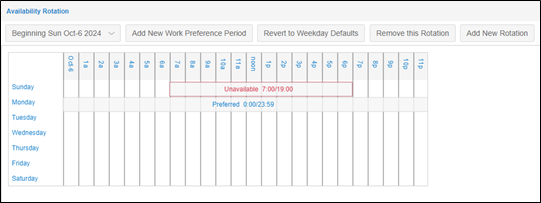
Edit the properties of the rule as needed in the Adjust Availability Rule window. If you want to remove the rule, enable the Remove this Rule check box.
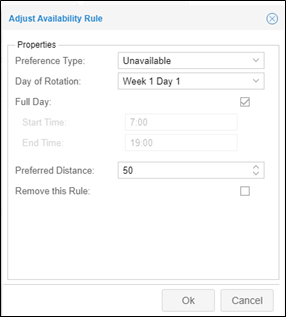
For more information about Adding Employee Availability Preferences, download the PDF document Adding Employee Availability Preferences.